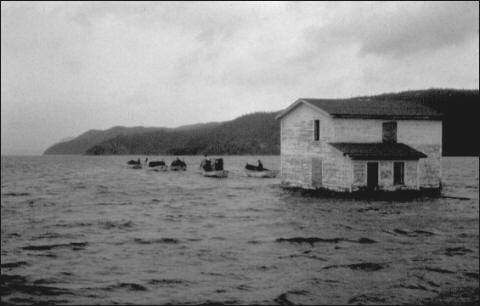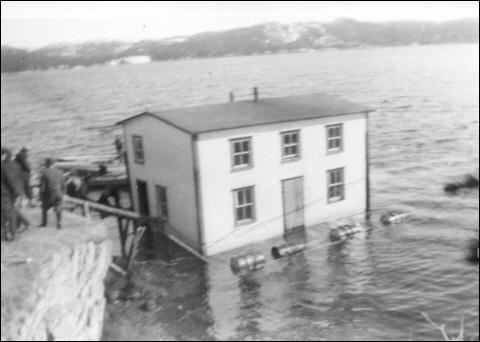Craig Grandy
 Newfoundland, as we all know, is a kayaker’s paradise. The Burin Peninsula is one of its best-kept secrets. Known to the locals as the “Boot,” this neck of land sticking out on the south coast of the province offers some of the best paddling on the Rock.
Newfoundland, as we all know, is a kayaker’s paradise. The Burin Peninsula is one of its best-kept secrets. Known to the locals as the “Boot,” this neck of land sticking out on the south coast of the province offers some of the best paddling on the Rock.
This past September, I had the opportunity to spend a beautiful day on the water, paddling to the resettled communities of Little Harbour and St Joseph’s, located on the Placentia Bay side of the Peninsula. I was accompanied by paddlers Bert Stone of Marystown, Bob MacLeod of Burin, and Bob Smith of Grand Bank.
The day started when we all met about 7:00 a.m. at Tim Horton’s in Marystown. A quick coffee and we are heading north on route 210 towards the Boat Harbour intersection on the main Burin Peninsula highway. About twenty minutes later, under sunny skies, we are on the Boat Harbour road heading towards Bay de l’Eau Inlet. Taking the first left on the Boat Harbour road will put you heading towards the picturesque community of Petit Forte. Bay de l’Eau is the first big inlet on the Petit Forte road, about 5 kilometres from Boat Harbour.
When we bring Bay de l’Eau in sight, the water is like a mirror. We park near the inlet, just as the road turns and goes along by the water. A little beach makes a nice launch area. As a point of interest, if you decide to put in at the bottom of the inlet near the bridge, you could have a bit of a struggle getting back. The water drops out of the inlet close to half a kilometre on a low tide.
By about 8:30 a.m., after a quick gear check, and the latest forecast, we are on the water. We head across the inlet about half a kilometre to the eastern shore of Bay de l’Eau. Following this shoreline will bring you right into the small inlet leading into Little Harbour about 8 kilometres away.
The scenery is spectacular as you round Bay de l’Eau Head. The sea stacks, and a rock arch formation are really interesting. You have two or three small landing spots on the way to Little Harbour, but mostly rock and high cliff.
As you paddle in through the inlet you will notice a beautiful old house on your left about halfway in. The once thriving community is now reduced to a few old houses and cabins used as summer cottages. We notice a house that appears to be in the water. A closer look brings us paddling by the kitchen window of a house that was towed in from the nearby community of Baine Harbour. The house has drums lashed to its sides and two wooden skids under the foundation. A few people staying in the cabins come down for a chat. They tell us they are waiting for a high tide to inch the house up past the high water mark. When we ask how they plan on getting this large two-storey house up on dry land, they explain that a Hock and tackle system, and lots of strong rope being towed by a longliner will do the job. We acknowledge that this sounds like a monumental task. One old gentleman summed it all up, “Nothing to it my son, come back next year she’ll be up on dry land with a patio around her.”
After a quick look around, and a little snack, we are on our way to St. Joseph’s about 4 kilometres away. When you come out of Little Harbour Inlet, keep to the northern shoreline. The entrance to St. Joseph’s is just around the head of land. The old community of St. Joseph’s is in a northeast direction in through the inlet. Head towards Pushthrough Pass where there is a small opening you can get through to enter the harbour. As you paddle around the harbour you get the feeling that this was once a fairly big community. Cabins, sheds, and small wharves dot the shoreline. We land on a small beach for a look around. You can see the history of the old town in the remnants of the old building foundations, and the weather beaten wharves. A lot of people are here for the weekend enjoying their summer getaway.
We are all feeling a little hungry by now, and lunch is the next thing on the agenda. Fisherman’s Brewis, scallops, homemade bread and a hot cup of tea. Can it get any better? After about a 90-minute break we are ready for the return paddle. As we exit the harbour through the narrow opening, we face a light to moderate westerly wind. We decide to paddle towards the western shoreline to stay in the lee of the breeze. When we round the point and start heading across the mouth of Little Harbour we have the westerly wind right in our face.
Before we tackle Bay de l’Eau Head we decide to land on a small beach for a break. We are not there long when a boat passing by drops in to make sure we are OK. He said it was a bit rough out around the head, but once you get around it you should have it OK. We thank him for dropping by to check on us, and tell him we should be fine. Bay de l’Eau Head was a bit of a challenge, but once around it, it was smooth paddling all the way back to the vehicles.
It is about 4:30 p.m. as we unpack the kayaks and load them onto the vehicle racks. We all have the same thoughts in our minds, “What a day! We definitely have to do this one again.”
Reprinted from Ebb & Flow, Winter 2007, the magazine of Kayak Newfoundland and Labrador. Photographs from the Resettlement: No Great Future website in the Maritime History Archive, Memorial University of Newfoundland.

